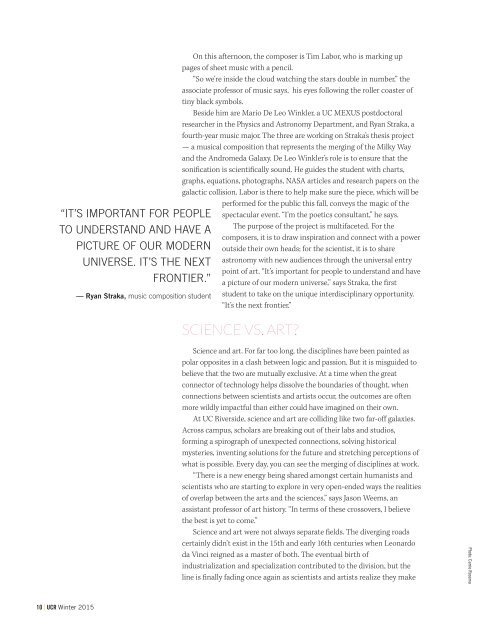UCR-Magazine-Spring-2015
UCR-Magazine-Spring-2015
UCR-Magazine-Spring-2015
Create successful ePaper yourself
Turn your PDF publications into a flip-book with our unique Google optimized e-Paper software.
“IT’S IMPORTANT FOR PEOPLE<br />
TO UNDERSTAND AND HAVE A<br />
PICTURE OF OUR MODERN<br />
UNIVERSE. IT’S THE NEXT<br />
FRONTIER.”<br />
— Ryan Straka, music composition student<br />
On this afternoon, the composer is Tim Labor, who is marking up<br />
pages of sheet music with a pencil.<br />
“So we’re inside the cloud watching the stars double in number,” the<br />
associate professor of music says, his eyes following the roller coaster of<br />
tiny black symbols.<br />
Beside him are Mario De Leo Winkler, a UC MEXUS postdoctoral<br />
researcher in the Physics and Astronomy Department, and Ryan Straka, a<br />
fourth-year music major. The three are working on Straka’s thesis project<br />
— a musical composition that represents the merging of the Milky Way<br />
and the Andromeda Galaxy. De Leo Winkler’s role is to ensure that the<br />
sonification is scientifically sound. He guides the student with charts,<br />
graphs, equations, photographs, NASA articles and research papers on the<br />
galactic collision. Labor is there to help make sure the piece, which will be<br />
performed for the public this fall, conveys the magic of the<br />
spectacular event. “I’m the poetics consultant,” he says.<br />
The purpose of the project is multifaceted. For the<br />
composers, it is to draw inspiration and connect with a power<br />
outside their own heads; for the scientist, it is to share<br />
astronomy with new audiences through the universal entry<br />
point of art. “It’s important for people to understand and have<br />
a picture of our modern universe,” says Straka, the first<br />
student to take on the unique interdisciplinary opportunity.<br />
“It’s the next frontier.”<br />
SCIENCE VS. ART?<br />
Science and art. For far too long, the disciplines have been painted as<br />
polar opposites in a clash between logic and passion. But it is misguided to<br />
believe that the two are mutually exclusive. At a time when the great<br />
connector of technology helps dissolve the boundaries of thought, when<br />
connections between scientists and artists occur, the outcomes are often<br />
more wildly impactful than either could have imagined on their own.<br />
At UC Riverside, science and art are colliding like two far-off galaxies.<br />
Across campus, scholars are breaking out of their labs and studios,<br />
forming a spirograph of unexpected connections, solving historical<br />
mysteries, inventing solutions for the future and stretching perceptions of<br />
what is possible. Every day, you can see the merging of disciplines at work.<br />
“There is a new energy being shared amongst certain humanists and<br />
scientists who are starting to explore in very open-ended ways the realities<br />
of overlap between the arts and the sciences,” says Jason Weems, an<br />
assistant professor of art history. “In terms of these crossovers, I believe<br />
the best is yet to come.”<br />
Science and art were not always separate fields. The diverging roads<br />
certainly didn’t exist in the 15th and early 16th centuries when Leonardo<br />
da Vinci reigned as a master of both. The eventual birth of<br />
industrialization and specialization contributed to the division, but the<br />
line is finally fading once again as scientists and artists realize they make<br />
Photo: Carrie Rosema<br />
10 | <strong>UCR</strong> Winter <strong>2015</strong>


